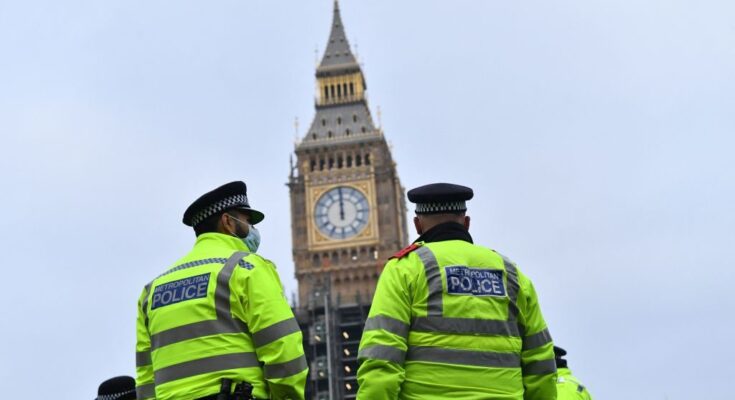How could it happen here, in one of London’s most coveted neighbourhoods and just a few steps from Harrods? A young father, only 24, stabbed to death for the watch on his wrist. The truth, of course, is that it could easily happen here, that Blue Stevens’ shocking murder on Wednesday night is just the latest sign of a city in chaos, with an indifferent mayor and the police increasingly struggling to respond.
London’s reputation for street crime is now on a par with Naples or Rio, and things have become so bad that it’s starting to threaten its lucrative hospitality industry. The prestigious PPHE hotel group has upped its security budget, citing a lacklustre police response to crime. Elsewhere, TV stars grapple with thieves in Kensington cafés, while the city’s elite are increasingly warned not to wear expensive jewellery out in public — lest they become the next Blue Stevens.
Yet amid the rising disorder, one crime stands out: phone theft. Around 80,000 were reported stolen in London last year, a significant rise from 2023. These industrial-scale numbers are reflected elsewhere: stolen handsets are sold to dealers, often owners of independent electronics shops, before being unlocked or stripped for parts. They’re shipped to Asia, Africa and the Middle East, where differences in regional blocking technologies means they’re easily recycled. “We had a victim whose iPhone was snatched,” says a detective I’ll call Chris. “Five days later, it paired with her Apple watch. The stolen phone was in Dubai.” Phone theft also drives fraud: unlocked, they allow thieves to access bank accounts and payment apps. It’s a very modern mixture of cyber-burglary, embezzlement and identity theft.
The Metropolitan Police, when not bickering with the tech industry over theft-proofing, pleads a dangerous lack of resources. They also point to successful proactive operations combatting thieves, involving undeniably gutsy motorcycle cops “nudging” fleeing offenders off their bikes — and risking the wrath of the Independent Office of Police Conduct if anything goes wrong. Yet on the thieves go, their loot now representing some two thirds of thefts right across London.
London’s iPhone theft hotspot is the junction of Oxford Street and New Bond Street. When I visit, the area feels spick and span, still basking in the afterglow of a recent facelift. New Bond Street, as ever, is a gilded temple of conspicuous consumption. It’s also pedestrian-friendly, with low curbs and wide pavements: an ideal escape route for thieves using e-bikes or scooters. The streets are peppered with alleyways, rat-runs and cut-throughs, perfect for what police still quaintly term “decamping” from the scene of the crime.
Sadly, I see no sign of the Metropolitan Police on this sunny weekday afternoon. Instead, Oxford Street is patrolled by the occasional private security guard. On New Bond Street, sharp-suited heavies, wearing bodyguard-style earpieces, loiter in shop doorways. As for the shopping public, they’re busy staring into their phones and bumping into each other. In short? The area’s an El Dorado for thieves. Luckily, I spy no suspects loitering with intent. It’s just after 12 — and, if experience is anything to go by, they’ll just be lighting their first spliff of the day.
“They’re usually under 18, not in work or education, and their parents don’t give a shit,” says Chris, who works at a busy London police station, of the typical phone snatcher. “Where I work, most are from an ethnic minority. Some are on the periphery of gang activity.” Chris’s observations are borne by the statistics. In 2022, for instance, around 60% of London’s robbery suspects were black or Asian. The age of offenders is significant too: dealing with young offenders is challenging for police. Because they’re still juveniles, it doesn’t matter if they’ve just robbed someone at knifepoint. Safeguarding and risk management procedures still apply, while custody sergeants want them discharged sharpish. Never mind that phone thieves often graduate working the County Lines, shipping drugs for big-shot dealers. “Once they’ve gone down that path,” Chris says, “there’s usually no going back.”
My patrol takes me to Jermyn Street, immaculately tailored men peacocking outside Turnbull and Asser. On Ormond Yard, a homeless woman injects herself under a fingernail with a hypodermic needle. Wasn’t London ever thus? You could be forgiven for thinking street robbery is as old as the city itself, from highwaymen to Dickensian gangs of pickpockets: a legacy brutally demonstrated by Britain’s lively history of deportations and public hangings. For the latter, Tyburn was the execution spot of choice; these days, the gallows have been replaced by Marble Arch, just at the bottom of Oxford Street.
In truth, though, that’s only half the story. From the interwar period until the Seventies, the capital’s streets were comparatively well ordered. Londoners lived in a culture of high trust, conditioned by wartime obedience. The streets were patrolled by physically imposing coppers. Any “clips around the ear” were administered without fear of phone cameras or CCTV. Mugging — or street robbery — was relatively unusual.
By the Seventies, though, robbery was on the up. Criminologists declared concerns over mugging a moral panic, preferring to concentrate on race and inequality rather than property rights. Such beard-stroking was of little consolation to mugging victims, or the cops tasked with catching offenders. That echoed a broader shift. During the Seventies and Eighties, crime became increasingly politicised and, yes, a fair share of the blame lies with the police — the Brixton riots were sparked by the racist application of “sus” laws, subsequently replaced by stop and search procedures under the Police and Criminal Evidence Act.
By the mid-Nineties, London was suffering another wave of muggings: nearly 24,000, a 50% rise in 1990 (in 2024, there were 35,000 cases of robbery reported, excluding non-violent theft). Launching “Operation Eagle Eye”, then-Commissioner Sir Paul Condon faced media opprobrium by warning “it is a fact that very many of the perpetrators of mugging are very young black people”. The politics of race has always dogged street crime investigation, and it drives cops nuts; as a robbery squad officer in Notting Hill, the majority of suspects were usually of Moroccan or Afro-Caribbean origin. Confronted with allegations of racism, or disproportionate stop and search, frustrated officers would ask: are people lying to us about the person who robbed them? Yet, somehow, the problem was always police prejudice. This in a city, remember, where nearly half of Londoners are now from ethnic backgrounds.
But if racism in the Brixton mould is a thing of the past, the Met’s structure remains problematic. The service was once divided into smallish divisions, based around local police stations. Then, later, it moved to borough-based policing. When I investigated robberies, there were no iPhones; thieves coveted laptop computers, Rolex watches and jewellery. On my first day on an “Eagle Eye” team, our detective sergeant took us to a café on Golborne Road. There, in the shadow of Trellick Tower, the man known as “Mick the Fish” (don’t ask) explained the café was popular with robbers. “You need to know your punters,” he explained.
“You need to know your punters”
We ate breakfast and bantered with suspects, our mutual loathing almost comedic. Officers cultivated informants, an activity now forbidden for street cops. At any rate, our team became part of the street’s weft and weave. This autonomy meant we’d arrest two or three suspects per shift, raid properties, restore stolen goods and take offenders off the street. We eventually received an intelligence report from an informant revealing how “the Golborne Road boys are sick and tired of the Notting Hill robbery squad”. We framed it. These days, of course, such behaviour might constitute harassment, but effective street policing isn’t always pretty. Knowing the game was up, our regular customers decamped to nearby Harrow Road, becoming a neighbouring division’s issue. You never fully eliminate crime, you merely move it around.
These days, of course, the Met has sold most of its police stations. Notting Hill nick is a satellite office, without public access. Plainclothes cops no longer eat fry ups with their suspects, like some west London ripoff of Heat. Nor are they embedded in the communities they police. To save money on admin costs, the Met created multi-borough “Basic Command Units”. Notting Hill division, for example, was swallowed into a vast “Central West BCU”, covering three boroughs: Westminster, Kensington & Chelsea, and Hammersmith & Fulham. Westminster (nicknamed “Westmonster” by Met officers, due to its unwieldiness) has London’s highest incidences of phone theft. To put the figures into context, the “CW BCU” has a population of over half a million, not including tourists. That’s about the same as Liverpool or Bradford. Yet the BCU is policed, 24/7, by only 1800 officers — and most of those aren’t uniformed response constables.
“Each BCU only has one proactive team,” laments Chris, one overworked officer. I ask how many officers work on each team. “On average,” he answers, “a dozen or so plainclothes cops.” They concentrate on the “big” stuff: gangs and knife crime. That leaves phone thefts, left to neighbourhood policing teams without resources or experience. To be fair, senior officers aren’t clueless here. “When the Met was borough-based, we had relative autonomy when it came to problem-solving,” says David Spencer, a former detective chief inspector and now at Policy Exchange. “There were borough-based proactive teams to tackle street crime.” Not so now, with the introduction of monster BCUs.
Yet as my experience on Operation Eagle Eye taught me, there’s no substitute for putting a name to a face. Much of the blame, predictably, can be placed on bone-headed bureaucracy. For instance, officers have to comply with legislation concerning everything from health and safety to diversity. Crime reports, run on a notoriously unreliable new IT system called Connect, require meticulous evidence of compliance. Overwhelmed by the volume of allegations, officers find themselves reacting to crimes rather than crime-fighting. CID officers largely now exist to complete drop-down boxes on forms, issuing crime reference numbers for insurance claims.
“The guidelines crime managers must follow are over-prescriptive and unwieldy,” Spencer summarises. “They remove officer discretion.” For their part, senior detectives spend a disproportionate amount of their time reviewing cases, tracking performance metrics and “managing risk”. Spencer also cites the Met’s “victim-focussed” approach — a well-meaning initiative that nonetheless means more bureaucracy tracking “public satisfaction”. As a result, officers spend more time feeding investigative processes than actually dealing with crime.
As so often in modern British policing, meanwhile, radical change is frowned upon; the Met has little tolerance for dissent. The last thing an ambitious officer should do is rock the boat, despite New Scotland Yard heading full steam towards an iceberg. Such a sluggish corporate culture inevitably brings second-order challenges too. “Too many student officers are very young, very inexperienced and poorly-paid,” says Chris. “They were sold a lie when they joined, that policing was going to be like a TV drama.” Many quit. Then there’s the “toughness” question, the sense that some young officers just aren’t robust enough. “One lad started crying when a suspect began swearing at him,” Chris says. “I’m not kidding. He had to take the rest of his shift off. When experienced officers quit, due to pay and conditions, they wanted graduates to ‘professionalise’ the job. Now they’ve got them.”
Back in central London, I finish my patrol. Outside The Golden Lion pub in St James’s, I see London’s finest for the first time. Two police vans, full of bored-looking coppers. They’re probably policing a noisy pro-Palestine protest nearby, another reason why the Met struggles to patrol London’s streets. The service is pulled in every direction, drowning in a septic tank of political and administrative sludge.
No wonder Oxford Street’s snatchers are so brazen. It’s a lawlessness that transcends stolen iPhones — but has rather come to symbolise Britain’s threadbare social contract. Not that Whitehall seems to care. In its latest spending review, the Government virtually ignored policing, forcing council taxpayers to foot the bill for additional resources. Londoners shouldn’t expect anything from City Hall either. Sadiq Khan has been criticised for offering platitudes on phone crime, even as he focuses on post-theft blocking technologies over actually arresting thieves. He’s also been criticised for misrepresenting knife crime statistics and equivocating over stop and search.
That’s deeply unfortunate, and not just because a stolen iPhone will set you back £800. Street crime, after all, can easily escalate. A phone today, a Rolex tomorrow — and then a stabbing. The preventative measures necessary will always be the same: robust policing; stop and search; getting to know the suspects. Like all simple solutions, however, the gap between theory and practice is vast. Whichever way you look at it, there’ll be other victims like Blue Stevens.


